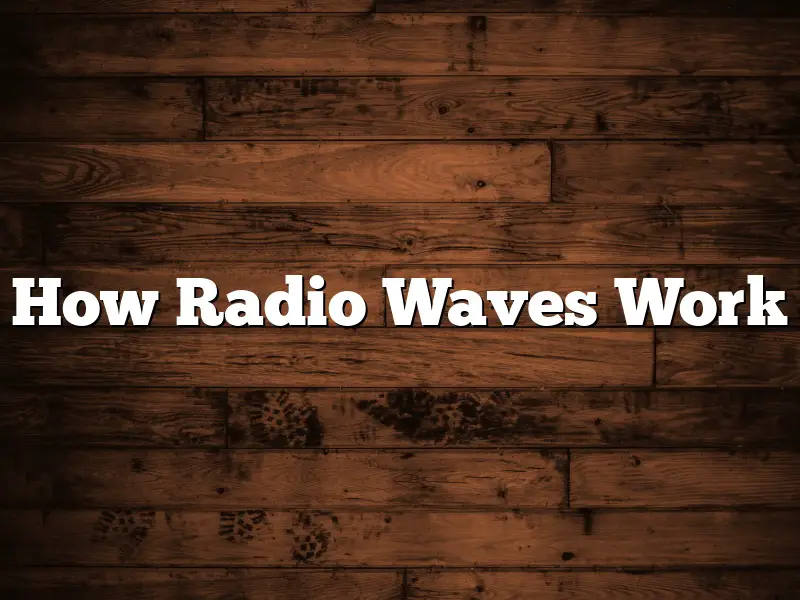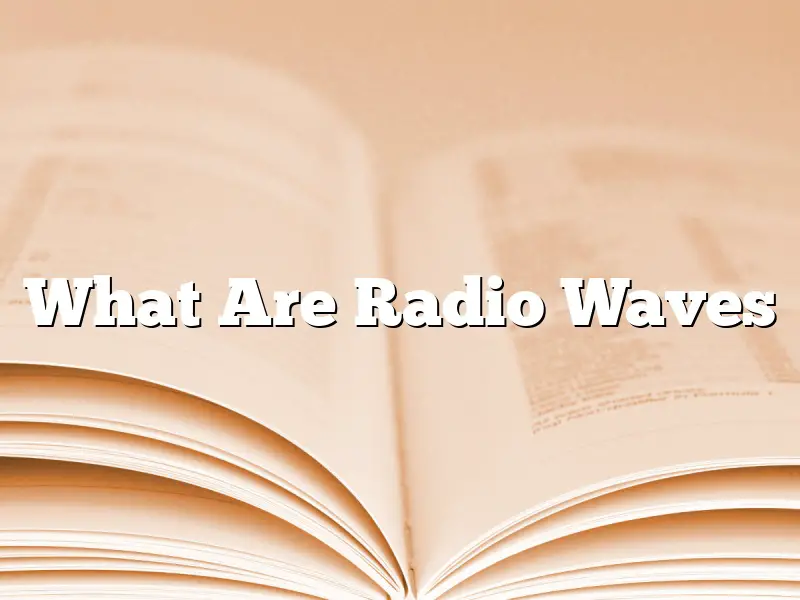There’s a new development in the ever-changing world of communication. Radio waves are now heading upward from Earth rather than just outward.
This opens up a whole new realm of possibilities for communication. For one, it means that satellites can be used for communication rather than just for GPS and other navigation purposes.
It also means that communication can take place between devices that are much further apart than was previously possible. This could be especially useful in situations where traditional communication methods are not available, such as in disaster relief efforts.
Researchers are still working on perfecting this new technology, but it holds a lot of promise for the future of communication.
Contents
- 1 What happens to radio waves as they reach the upper atmosphere?
- 2 What happens when radio waves are transmitted from the earth surface?
- 3 Do radio waves escape from Earth?
- 4 Do radio waves bounce off the atmosphere?
- 5 How far can radio waves travel?
- 6 How radio waves are reflected back to the Earth?
- 7 Are radio waves harmful to humans?
What happens to radio waves as they reach the upper atmosphere?
Radio waves are a type of electromagnetic radiation that is used for communication. They are sent out by radio stations and travel through the air until they reach a receiver. The farther the radio waves travel, the weaker they become.
As radio waves reach the upper atmosphere, they are affected by the different gases and particles that make up the atmosphere. The ions in the atmosphere can cause the radio waves to scatter, which means that they spread out and become weaker. The radio waves can also be absorbed by the atmosphere, which can cause them to be completely blocked from reaching the receiver.
The amount of scattering and absorption that takes place depends on the type of atmosphere and the frequency of the radio waves. Radio waves that are sent at a high frequency are more likely to be scattered and absorbed than those that are sent at a low frequency.
The upper atmosphere can also cause the radio waves to bend. This happens when the radio waves pass from one type of atmosphere to another. The different densities of the atmospheres can cause the waves to bend.
Radio waves can also be reflected off of the atmosphere. This happens when the waves hit a gas or particle in the atmosphere and are reflected back down to Earth. The amount of reflection that takes place depends on the type of atmosphere and the frequency of the radio waves.
Overall, the upper atmosphere can cause the radio waves to spread out, weaken, and be blocked from reaching the receiver. The amount of scattering, absorption, and reflection that takes place depends on the type of atmosphere and the frequency of the radio waves.
What happens when radio waves are transmitted from the earth surface?
Radio waves are transmitted from the earth surface when an electrical current is sent through an antenna. The antenna sends out an electric signal in all directions. The electric signal is made up of radio waves. The more electric current that is sent through the antenna, the more radio waves are created.
Radio waves are sent out in all directions, but they are not all the same strength. The waves that are sent out the farthest from the antenna are the weakest. The waves that are closest to the antenna are the strongest.
Radio waves can be reflected off of things. When they hit something, some of the waves are reflected back to the antenna. The amount of reflection depends on how big the object is and how smooth the surface of the object is.
Radio waves can also be absorbed by things. When they hit something, some of the waves are absorbed into the object. The amount of absorption depends on how big the object is and how absorbent the object is.
Radio waves can also pass through things. When they hit something, some of the waves pass through the object. The amount of transmission depends on how big the object is and how porous the object is.
The strength of the radio waves decreases as they travel away from the antenna. The strength of the waves also depends on the type of antenna that is used. The more directional the antenna is, the stronger the waves will be in the direction that the antenna is pointed.
Do radio waves escape from Earth?
Radio waves have been used for communication for over a century. They are used for transmitting voice, data, and images. Radio waves are also used for navigation and radars. So, do radio waves escape from Earth?
The short answer is no. Radio waves do not escape from Earth. Radio waves stay in the Earth’s atmosphere.
Radio waves are a form of electromagnetic radiation. Electromagnetic radiation is energy that travels through the air or space in the form of waves. Radio waves are a type of electromagnetic radiation that have a wavelength of between about 1 meter and 300 meters.
Radio waves are created when an electric current passes through a metal antenna. The metal antenna creates a magnetic field. The electric current creates a disturbance in the magnetic field. This disturbance creates waves of energy that travel through the air.
Radio waves are used for communication because they can travel long distances. They can travel through the atmosphere and the Earth’s magnetic field. Radio waves can also travel through the vacuum of space.
Radio waves do not escape from Earth because they are blocked by the Earth’s atmosphere. The Earth’s atmosphere is made up of different layers of gas. The Earth’s atmosphere blocks radio waves from escaping into space.
The Earth’s atmosphere also blocks other types of electromagnetic radiation from escaping from Earth. These types of radiation include ultraviolet radiation and x-rays.
Radio waves are used for communication because they can travel through the atmosphere and the Earth’s magnetic field. Radio waves can also travel through the vacuum of space.
Radio waves are used for navigation and radars because they can travel through the atmosphere and the Earth’s magnetic field. Radio waves can also travel through the vacuum of space.
Do radio waves bounce off the atmosphere?
Do Radio Waves Bounce Off The Atmosphere?
Radio waves are a type of electromagnetic radiation, which means they are made up of oscillating electric and magnetic fields. These waves can travel through both solids and liquids, but they are affected by the atmosphere.
The density of the atmosphere affects the speed of radio waves. The higher the density, the slower the waves will travel. Radio waves also bounce off the atmosphere, which is known as refraction.
The amount of refraction that a wave experiences depends on the angle at which it hits the atmosphere, as well as the atmospheric conditions at the time. In general, the higher the frequency of a wave, the more it will be affected by the atmosphere.
Radio waves are used for communication all around the world. Television, radio, and cell phone signals are all transmitted through radio waves. By understanding how the atmosphere affects these waves, we can better design antennas and transmission systems that can send and receive signals over long distances.
How far can radio waves travel?
Radio waves are a type of electromagnetic radiation that travels through the air and can be received by antennas. They are used for communication and can travel a great distance.
The distance that radio waves can travel is affected by a number of factors, including the power of the transmitter, the type of antenna, the atmospheric conditions, and the terrain. Radio waves can travel for hundreds or even thousands of miles under ideal conditions.
The longest distance ever achieved for radio communication was over 10,000 miles, between England and Australia. Radio waves can also travel around the curved surface of the Earth, allowing for communication between continents.
How radio waves are reflected back to the Earth?
Radio waves reflect off the Earth and back to the spacecraft. The spacecraft can determine the distance to the Earth by measuring the time it takes for the radio waves to travel from the Earth to the spacecraft and back.
The speed of light is a constant, and so by measuring the time it takes for the radio waves to travel from the Earth to the spacecraft and back, the spacecraft can calculate the distance to the Earth.
The spacecraft sends a signal to a ground station on Earth, and the ground station measures the time it takes for the signal to travel from the spacecraft to the ground station and back.
The ground station then sends a signal to the spacecraft, and the spacecraft measures the time it takes for the signal to travel from the ground station to the spacecraft and back.
By subtracting the two times, the spacecraft can calculate the distance to the ground station.
Are radio waves harmful to humans?
Radio waves have been around for over a hundred years and during that time there have been a lot of myths and misconceptions about their health effects. Are radio waves harmful to humans? Let’s take a closer look.
The electromagnetic spectrum is a range of frequencies that extends from low-frequency radio waves to high-frequency gamma rays. Radio waves are a part of the electromagnetic spectrum and are generated when an electric current flows through an antenna.
Radio waves are used for communication and have many practical applications, such as television, cell phones, and WiFi. They are also used for navigation, such as in GPS receivers, and for heating and cooling buildings.
Radio waves are non-ionizing radiation, which means they do not have enough energy to break the chemical bonds in molecules. This is in contrast to ionizing radiation, such as X-rays and gamma rays, which have enough energy to break the chemical bonds in molecules and can cause damage to cells and DNA.
So are radio waves harmful to humans? The answer is no. Radio waves have been studied extensively and there is no evidence that they have any health effects. They are a safe and effective way to communicate and have many other practical applications.




